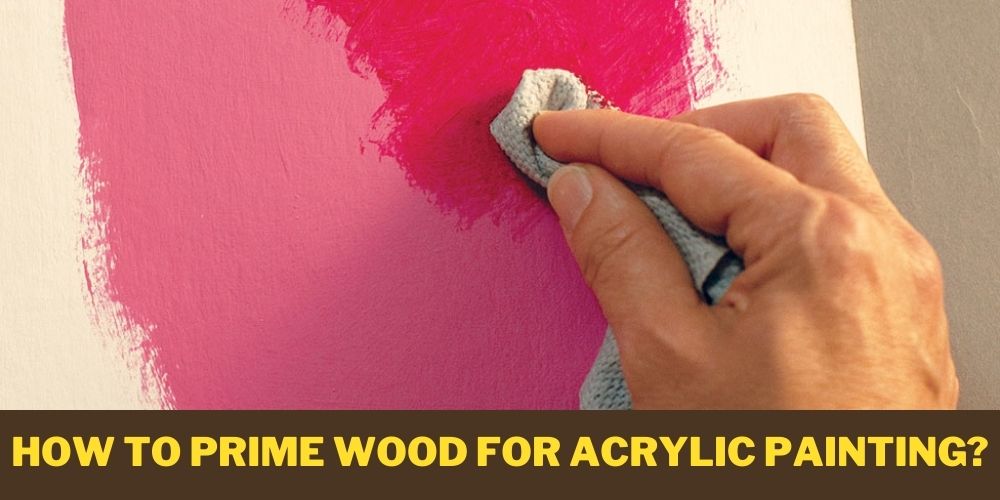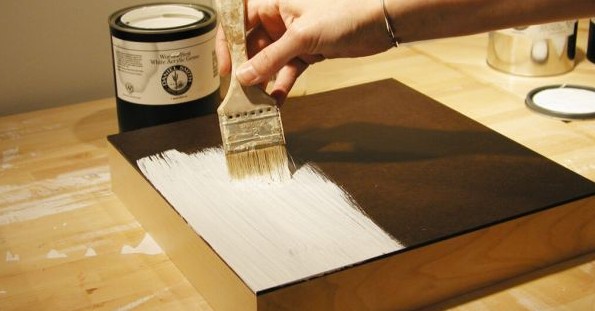Acrylic painting is one of the best options to create desired designs on wood. But before you can start your venture, you will have to prepare the wood by priming.
So, what’s priming, and why is it essential? And how to prime wood for acrylic painting?
One of the best advantages of priming wood before applying acrylic paint is that even light-colored wood looks vibrant on the wooden surface. Unfinished or raw wood tends to absorb acrylic paint; hence, it will never get your desired designs on its surface.
At the same time, primers have high-solid contents, which reduce the absorption capacity of the wood.

On the other hand, if you ignore priming the wood before painting, the paint would look fine for a while, but in a few days or months, it will start coming out like flakes.
By now, you must be well aware of the fact that priming wood is paramount. Hence we have researched different techniques which one can use before priming wood.
So in short, here you will learn exactly how to prime wood for acrylic painting, but before that you need whether doing that is necessary or not.
Do you need to prime wood before acrylic painting?

One of the most common mistakes painters make is they tend to ignore the priming step and directly proceed to paint to the wood. It is one of the most important steps one has to perform while applying acrylic paint on wood to seal the top-most surface of the wood.
Primers have the potential even to make light colors look more vibrant. Once you have applied primer on the wood, you will have to be patient before you can start painting to ensure that primer gets dried.
If you are looking to make the surface more smooth, you can repeat the process several times. In this case, the more, the merrier option works well.
How do you primer bare wood for acrylic painting?
A common mistake new painters make is they directly apply the first coat of the paint without inspecting the wood. If the wood is not properly primed before painting, the paint and the wood will get separated once the paint is dried on the wood.
To ensure that paint lasts for long on the wood, here is the procedure you have to follow while priming the wood before painting.
How do you prepare the wood before priming?
#1: Clean the bare surface of the wood:
Before applying the primer, you need to inspect and clean the bare surface of the wood. You can observe the surface of the wood and if you find anything missing like a screw or board, replace it with a similar item to ensure that you don’t disrupt its look. Once you have replaced all the broken items, it is now the best time to clean the surface.
To ensure that acrylic paint and wood bond well, clean the bare surface of the wood with TSP and water mixture. Also, give it some time to dry to prevent mold growth.
#2: Place the wood for proper sanding:
Before you can start sanding the wooden surface, you can keep it on a bench stop. A piece of wood, if kept on the benchtop, will be held in the best place at the time of sanding.
#3: Sand the wood:
One of the best advantages of sanding the wood with sandpaper is it makes small dings and scratches on the surface of the wood, which allows quick binding of the acrylic paint and the wooden surface. One can also use a handheld orbital sander or strips of smaller sandpapers. You have to sand the entire surface, including the corners, to maintain an even tone.
#4: Clean after sanding:
Without any doubt sanding the wooden surface will create a lot of dust; hence you will have to ensure that you use a shop vac that efficiently removes the dust from the surface; hence you will not have floating dust inside the room.
Moreover, dust particles can also be allergic, and they can also cause an uneven structure on the wood while painting.
#5:Seal (2 coats)Apply a sealant Wood sealer for acrylic painting :
Once you are done with sanding, you must now move on to the final stage of the preparation, where you have to seal the wooden surface to ensure that it doesn’t absorb the acrylic paint.
To seal the wood, you can either go with Sargent Art 22-8808 Gloss sealant or Aleene’s spray sealer. It is also important you apply the coating twice to get a better finish.
How to Prime wood for Acrylic Painting

Apply the first coat of the wood primer and let it dry completely before you can go for the final primer coating. Firstly, prime the front and let it dry for a few hours, and then apply the primer on the back. You can also use a brush or a paint roller to apply primer to the wood.
It is also important that you don’t delay the procedure as it can have an adverse impact on the wood. It is vital to ensure that you follow all the steps correctly to avoid messing everything up.
We recommend you to go with Liquitex 7616 professional Gesso or Sargent Art 16Oz white primer and Handy Art 440-003 white primer if you are looking for white primer Gesso in the market.
Most of the experts would recommend going with white gesso primers for wood as they are best in the business if you want to use acrylic paint on the wood. You can also sand the wood once the primer is dried and apply more primer on it for a smooth finish.
What can I use instead of gesso?

Undoubtedly, Gesso is one of the highly-suited primers in the world when the concern is about preparing the wood before priming. To be honest, it is not difficult to create your own primer if you know about basic chemicals. Generally, Gesso is made from a mixture of chalk, gypsum, and a pigment to bind them together.
So, you can either make your own Gesso, or we would recommend you to go with acrylic primers as they are the best alternative for the gesso. On the other hand, if you are looking for cheaper alternatives to gesso, you will have to bring all the ingredients at home and make your own Gesso.
Do I need to prime plywood before painting?
Plywood is not a magical wood, and just like any other wood, it needs to be prepared before painting. The quality of the preparation of the plywood will reflect how the finishing is produced.
You have to use a primer before you can start your acrylic painting artwork on the plywood. Also, don’t forget to sand and prime the plywood before painting.
Frequently Asked Questions (FAQs)
Get your answers here
Can you use acrylic paint on unfinished wood?
Undoubtedly, you can acrylic paint on unfinished wood, but doing so will also affect the quality of the artwork, and if you don’t apply the double coating, the primary coating might chip from the wooden surface after getting dried completely.
What is the best wood to paint with acrylics?
It is good to go with medium density wood like plywood or teak wood will do a great job if you want to paint with acrylics. Moreover, you can use any surface to paint with acrylics if you know how to prepare and prime the wood before painting with acrylics.
Can you use acrylic paint on wooden furniture?
Well, you can do any type of acrylic paint on wooden furniture but ensure that you double coat the paint and let it dry completely. We also recommend using a flat paintbrush and adding a thinner to acrylic paint before using it on the wooden furniture.
Conclusion:
Undoubtedly, acrylic paints offer the smoothest finish, but you have to prepare and learn how to prime wood for acrylic painting to make good use of the paint. You can either go with the options in this blog or shop for some of the best primers for the best results.



